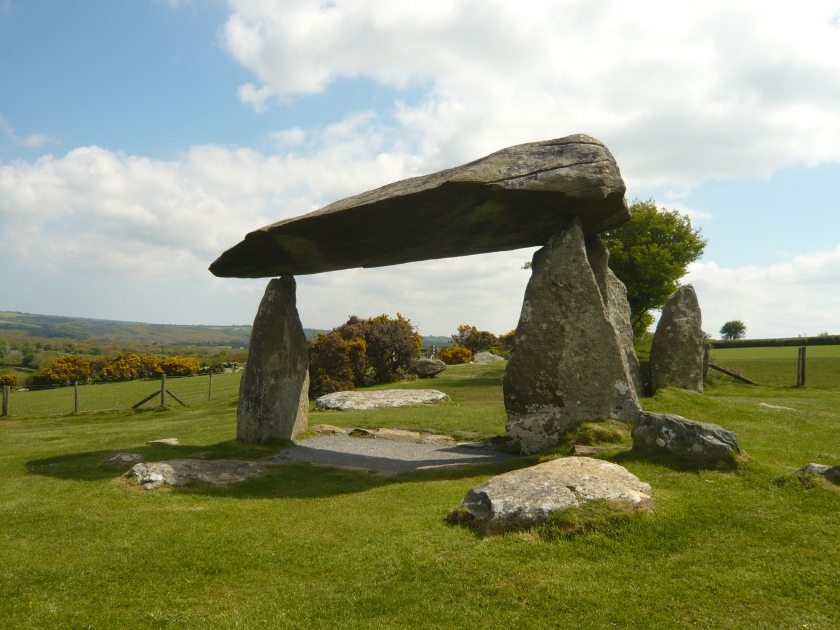The term dolmen has been unfashionable for a long time, as archaeologists classify this type of early Neolithic monument as a burial chamber, or in Ireland, as a portal tomb, rather than using terms such as dolmen or cromlech. On the OS maps they are marked as Burial Chambers. But maybe it’s more accurate to use a word like dolmen after all? A word that describes a large stone that’s elevated off the ground and perched, often spectacularly, on top (typically three) upright stones.
(Top image: Pentre Ivan, Pembrokeshire)

This post was inspired by a very interesting talk last week by the archaeologists Vicki Cummings and Colin Richards. They have spent 9 years investigating dolmens in Northern Europe and have recently published a book on the subject (see below). Much of their UK fieldwork was done on Anglesey and in other locations on the west coast of Wales where there are concentrations of dolmens.

They came to the conclusion that many dolmens were not built as burial tombs after all but as monuments built for display, to be gazed on with awe and wonder.

As well as being in a great location and wonderful to look at, the large elevated stone on Bach Wen is fairly unusual as it is covered in cupmarks!
Dolmens were constructed during the early Neolithic period and were the first endeavours to build monuments in stone, pre-dating dating later forms of burial tombs such as court tombs and passage graves. Many did indeed have burials within them or had a cairn of stones wrapped around them at a later date but it looked as if most had originally been built for display and wonder, rather than primarily for burial.

I think I’d prefer to see a fallen or broken capstone instead of an ugly pillar holding it together but it does demonstrate the weight of the stone and the skill it must have taken to lift it from the ground and position it securely on the tips of three upright stones.
Many capstones weigh over 100 tons. (The largest in N.W. Europe is at Kernanstown (Brownhill), Co. Carlow and it weighs about 160 tons!)

The pair of dolmens at Presaddfed contain different types of rock and were the subject of detailed excavation and investigation by the book’s authors. They day we went to Presaddfed we were frightened to go too close because the cows were grouped around the stones!
It’s easy to imagine that these impressive structures were built to be looked at and that people found them as amazing and awe inspiring as we do today.

Lligwy was a dolmen built in situ. The massive piece of limestone was excavated from the ground and propped up on smaller stones. A hollow was left underneath where the stone came out of the ground.

Dyffryn Ardudwy Dolmens




This really is a lovely setting. Two dolmens sit on a bed of stones in the shade of the trees and from their elevated position the sea is visible down below. The smaller dolmen was built first and the larger one to the east was built at a later date.

A platform of stones around the monument is a feature that was found at other dolmen sites. These were not flat stones made for walking on but more decorative stones such as rounded river stones or rocks of a different colour. They would have been specially chosen and placed there to enhance the image of the dolmen.
The village of Dyffryn Ardudwy is on the coast road half way between Harlech and Barmouth. As you head south out of the village, a long straight road leads up the hill to Cors y Gedol Hall, from where there’s a very pleasant walk to another dolmen.

I’ve just started reading this book and I can see already that I’m going to enjoy it immensely. It’s a very detailed and comprehensive reappraisal of dolmens in northern Europe but the writing style is very readable and it’s illustrated with lots of photos!

The cover of their book shows Proleek dolmen in Co. Louth. This is in the grounds of the lovely Ballymascanlon Hotel, which was our base for one of our Ireland trips. We not only had the treat of great food and hospitality but also had the surprise of both a dolmen and and a wedge tomb in the hotel grounds!
Vicki Cummings is Professor of Neolithic Archaeology at the University of Central Lancashire and Colin Richards is Professor of Archaeology at the University of the Highlands and Islands.


That’s a lovely collection of ancient monuments! And ‘dolmen’ and ‘cromlech’ are such wonderful words!
✨🙏🕉☀🌙⚖🪔🕊♾🈚☯🌍🐲🙋♂️
LikeLiked by 1 person
I quite agree!
LikeLiked by 1 person
Very interesting post, thanks. There’s one at Manorbier in South Pembrokeshire right next to the coast path. It’s known as ‘Kings Quoit’ , there’s a photo of it on this post https://shortwalkslongpaths.com/2019/03/01/5-coast-path-lydstep-haven-to-manorbier-beach/
LikeLiked by 1 person
We know the coast path from Stackpole westwards but unfortunately we’ve never made it to Manorbier. I’ve seen pictures of Kings Quoit, though.
LikeLiked by 1 person
As you’re probably aware they’re less common in Scotland but there’s a good one at Edinchip near Balquhidder in Perthshire: http://www.stravaiging.com/history/ancient/site/edinchip/
LikeLike
Thanks, I didn’t know about that one! It’s unusual. Maybe a Clyde type cairn that started off as a dolmen?
LikeLiked by 1 person
Yes, it is a bit odd. I’ve seen burial chambers inserted into Clyde-type cairns but not with a capstone. It would be interesting to know if it started off as dolmen and then had a cairn built up around it.
LikeLiked by 1 person